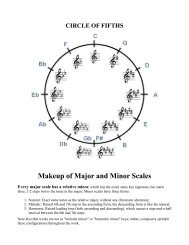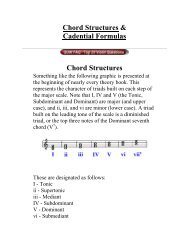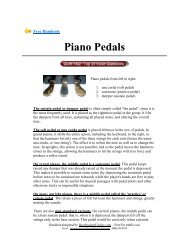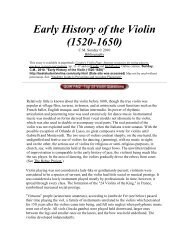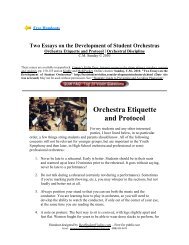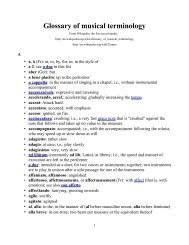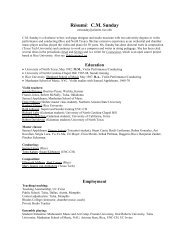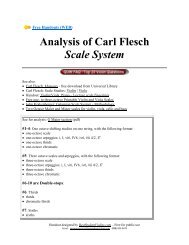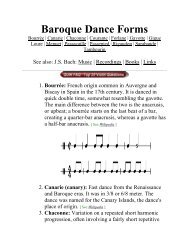Bridge Setup and Maintenance of Violins/Violas - Best Student Violins
Bridge Setup and Maintenance of Violins/Violas - Best Student Violins
Bridge Setup and Maintenance of Violins/Violas - Best Student Violins
You also want an ePaper? Increase the reach of your titles
YUMPU automatically turns print PDFs into web optimized ePapers that Google loves.
Web: http://beststudentviolins.com/ Toll free: (888) 823-3675Email: customerservice@beststudentviolins.com<strong>Bridge</strong> Set up Instructions (needed for our budget SAGAinstruments ONLY):"Belly" side should face toward the scroll.Violin bridges have a flat side <strong>and</strong> a rounded ("belly") side. [See closeup photograph, above.] The"belly" side needs to face the scroll. Loosen the strings <strong>and</strong> set the feet <strong>of</strong> the bridge between the nicksin the F holes, with, as mentioned, the rounded side <strong>of</strong> the bridge facing the scroll <strong>and</strong> fingerboard.Make sure the bridge is straight up <strong>and</strong> down, at right angles to the top <strong>of</strong> the instrument, <strong>and</strong> not tiltedin either direction. Please contact customer service if you experience any difficulties. We will be happyto help you.Cleaning/Polishing <strong>and</strong> Removing Dust Bunnies1. Never use any household products on an instrument; only use those products especiallydesigned for violins. Rubbing alcohol <strong>and</strong> four-in-one oil are the only two exceptions I canthink <strong>of</strong>; rubbing alcohol for the strings, <strong>and</strong> a tiny dab <strong>of</strong> oil on the bow screw if it's fussy. NoElmer's Glue, furniture polish, chemicals <strong>of</strong> any kind, varnish remover, etc.- 1 -
2. Use a small amount <strong>of</strong> polish/cleaner <strong>and</strong> gently buff with a dry cloth until dry.3. Let the instrument sit out for a while (out <strong>of</strong> its case), so it can air dry.4. If you are going to use polish, don't polish over twice a year; in between times, just dust theinstrument <strong>of</strong>f with a clean, dry cloth after playing. Too much polish can lead to build-up <strong>and</strong>attracts dirt.5. If you're not clear whether your violin has a French polish, test a tiny spot before using anyproduct. Discontinue immediately if the area becomes sticky.6. Don't let rosin, skin oils or dirt build up on the strings or the wood; the best way to keep theinstrument clean is to wipe it <strong>of</strong>f with a dry cloth after every playing session.7. In the process <strong>of</strong> cleaning/polishing the instrument, if you see any cracks, take it to a luthier <strong>and</strong>have them repaired. Don't polish the instrument until this is done; polish in the cracks willinterfere with the repair.8. In the process <strong>of</strong> cleaning/polishing, make sure not to move the bridge or damage the f holes;take care that you don't snag your cleaning cloth on the intricate carving <strong>of</strong> the bridge.9. If the instrument has a really thick build-up <strong>of</strong> rosin <strong>and</strong> dirt, you should take it to a luthier <strong>and</strong> haveit cleaned.10.Carefully shake the polish before using, <strong>and</strong> use a small amount, about the size <strong>of</strong> asmall coin.11.Fiddlebrite: A luthier told me that it's really not a polish, but a cleaner. And it maybe used to clean the stick <strong>of</strong> the bow (don't get it on the hair), the violin wood, <strong>and</strong> thestrings. It is appropriate for all so-called "student instruments," but you should not useit on expensive instruments with French varnish (which young beginners should nothave anyway, in my opinion.) For very expensive instruments, you should useregular cleaner <strong>and</strong> polish, or better still, just dust the instrument <strong>and</strong> have itpr<strong>of</strong>essionally cleaned periodically.12.Cautionary note: Don't confuse Fiddlebrite with the regular cleaner <strong>and</strong> polishproducts. Fiddlebrite may be used to clean not only the wood, but the strings.Other products are designed only for the wood <strong>of</strong> the instrument (not thefingerboard, either, but the wood <strong>of</strong> the body <strong>of</strong> the instrument) <strong>and</strong> must not beused on violin strings.13.An alternative way to clean violin strings, is to take a couple <strong>of</strong> clean, dry cloths,folded several thicknesses; place one, several thicknesses, on the violin wood directlyunder the "playing area" (the area between the end <strong>of</strong> the fingerboard <strong>and</strong> the bridge), <strong>and</strong> place anothercloth, at least double thickness, on the fingerboard, between the fingerboard <strong>and</strong> the strings. Then takeanother clean, dry cloth <strong>and</strong> put just a tiny dab <strong>of</strong> rubbing alcohol on the tip <strong>of</strong> a corner <strong>of</strong> thecloth, <strong>and</strong> clean your strings with that. You must not get any <strong>of</strong> the alcohol on the wood <strong>of</strong> theviolin, or on the fingerboard. Make sure that the cloths you use don't have soap or chemicalresidue on them. Using alcohol to clean the strings must be done very carefully, as any drop <strong>of</strong>alcohol on the wood may damage the wood permanently. I prefer using the Fiddlebrite. Anadditional alternative way to clean the strings is to use the cork from a wine bottle. I've neverdone this, but it's <strong>of</strong>ten mentioned.14.The common way <strong>of</strong> removing dust bunnies from inside the violin is to put 1/2 cup <strong>of</strong> DRYuncooked rice in the f holes, <strong>and</strong> then turn the instrument upside down, <strong>and</strong> shake out the rice.15.Other issues: when you take the violin out, check the strings to make sure they're notunraveling, make sure the bridge is sitting up straight, make sure the chin rest is not loose,make sure the fine tuners are not rattling. Don't forget to loosen the bow <strong>and</strong> remove theshoulder rest when you put the instrument away.- 2 -
How do you change a violin or viola string, or restring a violin orviola?If you're going to replace all the strings, I would not take them all <strong>of</strong>f atonce, but replace them one at a time, the outside strings first, then theinside. By doing them one at a time you can retain the placement <strong>of</strong> thebridge <strong>and</strong> also better avoid having the soundpost fall. It's also crucial thatyou put the strings in exactly the correct/same peg, <strong>and</strong> not change that. Ifthe pegs are lower left, upper left, upper right, lower right, the violin stringsneed to be: G, D, A <strong>and</strong> E. Viola strings: C, G, D <strong>and</strong> A.1. Carefully examine the strings <strong>and</strong> the way they are attached to yourtailpiece <strong>and</strong> to the pegs in the peg box.2. Remove the string.3. Attach the new string to the tailpiece, either to the fine tuner or looping through the hole in thetailpiece, depending on the way it was before, if you're not changing the setup; the top string (Eon violin) will normally always have a fine tuner; the other strings may or may not use a finetuner. If you have a Wittner style tailpiece, all four fine tuners will be built in.4. If you're changing the E (E on violin, A on viola), make sure the "doughnut"--the little either sleeveor black, doughnut shaped rubber ring--is going to be in place under the string when it crosses thebridge.5. Pull the string towards the pegbox, <strong>and</strong> insert the tip <strong>of</strong> the string into the hole <strong>of</strong> theappropriate peg.6. Turn the string in the direction away from you, if the violin or viola is facing you. As you turnthe peg away from you, be sure that you wind the string against the side <strong>of</strong> the peg box. Never force apeg; always turn it down (towards you) first, <strong>and</strong> then back up. Again, make double sure that thestrings are attached to the correct peg; otherwise they may cross each other <strong>and</strong> cause a problem, <strong>and</strong>the balance will be <strong>of</strong>f.7. Tighten it a bit but not too tight, get the pitch from a tuner or another violin, <strong>and</strong> tighten thestring slightly higher than the prescribed pitch (so it can stretch).8. Repeat this process on other strings you wish to change.9. While doing this, you might also want to examine the nut to see that it's not too deep, or sorough that it may break the string, especially on the top string. If it needs smoothing, you mayneed to take it to a luthier to do that.10.When you're through changing the strings I would tune the one(s) changed up slightly, <strong>and</strong>leave the instrument out (or with the case open, if you can), so the new string(s) can adjustmore quickly. Before you play, you will <strong>of</strong> course tune carefully.For assistance with:a. How to protect the violin from extremes <strong>of</strong> temperature <strong>and</strong> humidityhttp://beststudentviolins.com/StringCareSpecs.html#6b. Categories <strong>of</strong> stringshttp://beststudentviolins.com/StringCareSpecs.html#9c. String setshttp://beststudentviolins.com/StringCareSpecs.html#string_sets- 3 -
d. <strong>Bridge</strong> set uphttp://beststudentviolins.com/StringCareSpecs.html#10e. Tuning instructionshttp://beststudentviolins.com/StringCareSpecs.html#11f. My pegs are not working right; how do I fix them?http://beststudentviolins.com/StringCareSpecs.html#12g. My chinrest came <strong>of</strong>f; how can I fix it?http://beststudentviolins.com/StringCareSpecs.html#13h. My tailpiece came <strong>of</strong>f; how can I fix it?http://beststudentviolins.com/StringCareSpecs.html#14i. Muteshttp://beststudentviolins.com/terms.html#mutej. Rosinhttp://beststudentviolins.com/StringCareSpecs.html#8k. Fingerboard tapes <strong>and</strong> pinky padshttp://beststudentviolins.com/PedagogyTech.html#33l. What on earth is a "Violin Hickey"?http://beststudentviolins.com/StringCareSpecs.html#16m. How do you change a violin or viola string?http://beststudentviolins.com/StringCareSpecs.html#19String Resources• Accessories• Amusements• J.S. Bach: Music |Recordings | Books | Links• Baroque Resources• Bookstores• Common StringArticulations• Discussion Lists• Early History <strong>of</strong> the Violin• Essays in String Pedagogy• Errata in étude books• Fraud against MusicTeachers• Free H<strong>and</strong>outs• Free Music• Guides• Study Guide forPlacement Tests• Informal Surveys• Internet Resources forViolin/Viola <strong>Student</strong>s• Music Books on Kindle• Links• Media• Music Education• Non-Traditional StringSounds• Practice Books/Charts• Pr<strong>of</strong>essional Associations• Public Domain Materialsfor IntermediateViolin <strong>and</strong> Viola <strong>Student</strong>s• Sound Files• String Resources• Teacher Resources• Viola Resources• Teachers Directory• Violin/Viola FAQ• Violinists/Violists on theWeb- 4 -
Essays in String PedagogyAdministration <strong>of</strong> PostsecondaryMusic DepartmentsMath/Music/Literacy CurriculumUnitDiscussion: Careers in MusicTwo Essays on the Development <strong>of</strong><strong>Student</strong> OrchestrasMP3 Files: Tonality, Meter, StringArticulationsSight Reading for Rehearsal <strong>and</strong>AuditionsViolin Pedagogy <strong>and</strong> the Adolescent<strong>Student</strong>String Teachers QuestionnaireBook Review: George Leonard'sEducation <strong>and</strong> EcstasyElitism versus Popularism in MusicEducationNew Page:Ivan GalamianCopyright 2010 © SunMusic Strings- 5 -



